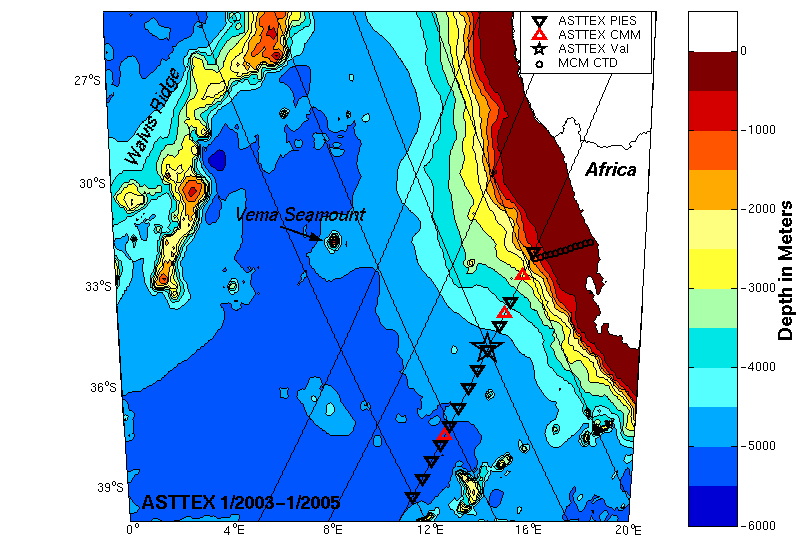Agulhas-South Atlantic Thermohaline Experiment
http://gyre.umeoce.maine.edu/ASTTEX/index.html
Background
Mass and thermohaline fluxes and their connection to global climate are still the subject of controversy. At a number of locations around the world, inter-ocean transport variability and the contrast in water mass properties between adjacent oceans can be large, with a potentially significant effect on the global climate. The Agulhas Retroflection region is a location of strong and variable inter-ocean transport, where warm, salt-enriched waters from the South Indian ocean enter the South Atlantic. The Agulhas Retroflection region as part of the warm water route is the only possible source for waters warm and saline enough to maintain the observed balance in the Atlantic thermocline, a balance which preconditions it for the formation of North Atlantic Deep water (NADW).
Science Goals
ASTTEX examines the fluxes of heat, salt and mass entering the South Atlantic ocean via the Agulhas Retroflection. The goal of the experiment is to provide a quantitative, multi-year Eulerian measurement of the strength and characteristic scales of Agulhas-South Atlantic mass and thermohaline fluxes, which contain a strong mesoscale component, resolving those fluxes on density horizons. While it has been estimated that up to half of the Agulhas-South Atlantic exchange is contained in mesoscale rings and eddies [Byrne, 2000] and the strength of the mesoscale fluxes could potentially vary a great deal in time, this has yet to be confirmed by a single, consistent set of observations — principally for want of a method with which to make the measurement. Ship-based surveys lack the temporal resolution required and the only prior mooring deployment that spanned the Cape Basin (conducted as part of the Benguela Sources and Transport experiment) was not at eddy-resolving resolution. An additional element of uncertainty is added by the extreme variability in size, strength and thermohaline signature of individual Agulhas eddies, which are dissimilar enough that some were at one time ascribed an origin in the Brazil Current (e.g., Smythe-Wright et al., [1996]).
Methods
The core of the ASTTEX field component is a 24-month deployment of sixteen moorings that monitor the transports of Indian Ocean water into the South Atlantic via the Agulhas Current at eddy-resolving resolution (70–80 km). The moored array consists of twelve pressure sensor-equipped inverted echo sounders (PIES) three near-bottom current meters (CM), and one validation mooring with six recording conductivity-temperature (CT) sensors. All of the moorings are deployed along a Topex-Poseidon/Jason satellite altimeter groundtrack. The mooring deployment was completed on January 16, 2003. Click here to view the cruise report (PDF).
ASTTEX also includes the large-scale analysis of regional sea surface height (SSH) anomaly fields during the field portion of the experiment as well as a long-term (12-year) analysis of Agulhas eddies in the SSH record (1992-2004). This component, spearheaded by Dr. Witter, provides a large-scale, low-frequency context for the experiment. The SSH fields are be derived from Topex-Poseidon and Jason-1 altimeter data.
ASTTEX uses a new technique which allows the mapping of fully depth-resolved salinity and temperature profiles from the combination of acoustic travel time and sea surface height. This method is called GEM-ETTA for Gravest Empirical Mode — 3D. GEM is a technique developed by Dr. Watts and some of his current and former students, and uses historic hydrography and acoustic travel time as proxies for vertically resolved in situ thermohaline profiles. A similar technique, ETTA (Enhanced Thermohaline Transport Analysis) was developed by Dr. Byrne in her doctoral thesis and uses historic hydrography and altimetric sea surface height in concert with acoustic travel time to distinguish thermohaline anomalies in the water column. ASTTEX has provided a context in which to integrate these two independently-developed methods as GEM-ETTA. Click here to see a flowchart of how the information we are collecting will be used to address the scientific goals of the project. To view a related retrospective analysis utilizing the GEM-ETTA method, click here.
ASTTEX Principal Investigators
- Primary PI:Deirdre Byrne, U. of Maine (SMS)
- Co-PI: Neal Pettigrew, U. of Maine (SMS)
- Co-PI: D. Randolph Watts, U. of Rhode Is. (GSO)
- Co-PI: Donna Witter, Kent State U.
- Collaborating Investigator: Christopher Duncombe Rae (MCM, South Africa)
Map of ASTTEX focus area and deployment locations
(click here for a text table of deployment positions)
This material is based upon work supported by the National Science Foundation under Grants No. OCE-0099177, OCE-0099182 and OCE-0095572 and NASA Grant No. NAG5-11132.
Any opinions, findings, and conclusions or recommendations expressed in this material are those of the author(s) and do not necessarily reflect the views of the National Science Foundation or the National Aeronautics and Space Administration.
